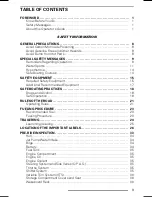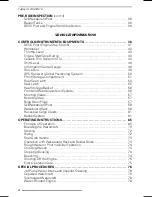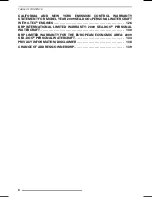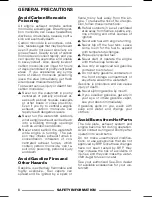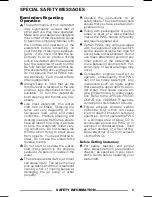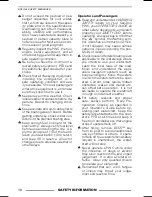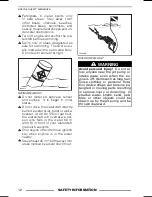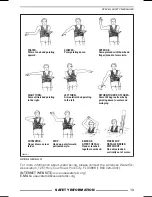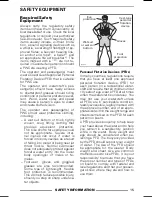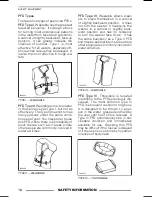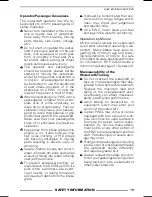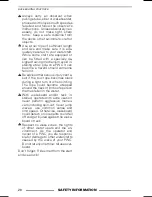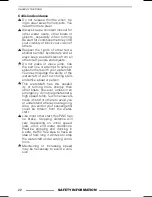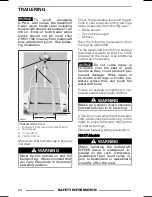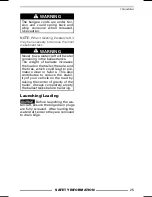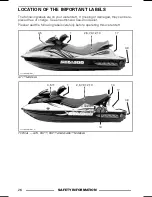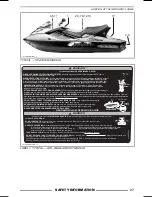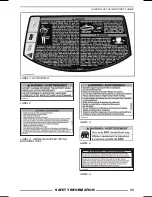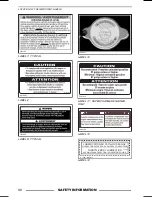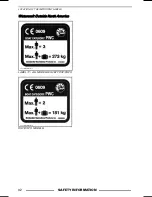
SAFETY EQUIPMENT
PFD Type V
, Wearable must be worn.
When inflated, it provides buoyancy
equivalent to Type I, Il or III PFDs.
When it is deflated, however, it may
not support some people.
Helmets
Some Important Considerations
Helmets are designed to offer some
degree of protection in case of im-
pact to the head. In most motorized
sports, the benefits of wearing a hel-
met clearly outweigh the drawbacks.
However, in the case of motorized wa-
tersports such as riding personal wa-
tercraft, this is not necessarily true as
there are some particular risks associ-
ated with the water.
Benefits
A helmet helps to reduce the risk of
injury in case of a head impact against
a hard surface such as another craft,
for example, in the case of a collision.
Similarly, a helmet with a chinguard
might help prevent injuries to the face,
jaw, or teeth.
Risks
On the other hand, in some situations
when falling off the watercraft, hel-
mets have a tendency to catch the
water, like a “bucket”, and put severe
stresses on the neck or spine. This
could result in choking, severe or per-
manent neck or spine injury, or death.
Helmets may also interfere with pe-
ripheral vision and hearing, or increase
fatigue, which could contribute to in-
crease the risk of a collision.
Weighing the Risks vs Benefits
In order to decide whether or not you
should wear a helmet, it is best to con-
sider the particular environment you
will be riding in, as well as other fac-
tors such as personal experience. Will
there be a lot of traffic on the water?
What is your riding style?
The Bottom Line
Since each option minimizes some
risks, but increases others, before
each ride you must decide whether
to wear a helmet or not based on your
particular situation.
If you decide to wear a helmet, you
must then decide what type is the
most appropriate
for the circum-
stances. Look for helmets that meet
DOT or Snell standards, and if possi-
ble, choose one designed for motor-
ized watersports.
Racing
Due to the nature of competition and
the proximity of other crafts, BRP rec-
ommends wearing a helmet in close
quarter PWC racing activities. Always
follow the helmet requirements of the
sanctioning organization.
Additional Recommended
Equipment
It is recommended that you acquire
additional equipment for safe, enjoy-
able cruising. This list, which is not all
inclusive, includes items you should
consider acquiring.
– Paddle
– First aid kit
– Charts
– Sunblock
– Emergency supply of drinking water
and food.
A cellular telephone in a waterproof
bag or container has also been found
to be beneficial to boaters when in dis-
tress or just for contacting someone
on shore.
________
SAFETY INFORMATION
________
17
Summary of Contents for 2009 Sea-Doo GTI Series
Page 9: ...SAFETY INFORMATION ________ SAFETY INFORMATION ________ 7...
Page 39: ...VEHICLE INFORMATION _______________ 37...
Page 83: ...MAINTENANCE INFORMATION _______________ 81...
Page 100: ...STORAGE AND PRESEASON PREPARATION 98 ______________...
Page 101: ...TECHNICAL INFORMATION _______________ 99...
Page 114: ...SPECIFICATIONS 112 ______________...
Page 115: ...TROUBLESHOOTING ______________ 113...
Page 123: ...WARRANTY ______________ 121...
Page 142: ...140 ______________...
Page 144: ...142 ______________...
Page 146: ...144 ______________...

